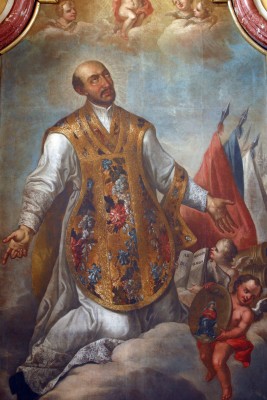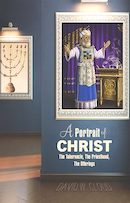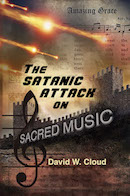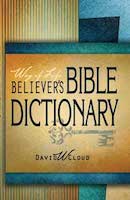866-295-4143, fbns@wayoflife.org

Ignatius was “converted” by reading the legendary lives of Catholic saints (in The Life of Christ by Ludolph of Saxony and The Golden Legend by Jacopo of Varazze) and by allegedly seeing a vision of the baby Jesus in Mary’s arms. Ignatius vowed to “serve only God and the Roman pontiff, His vicar on earth.”
He also devoted himself to Mary. At the pilgrimage site of Our Lady of Arantzazu in Spain he made a vow of chastity to her and entrusted himself to her protection and patronage. He spent an entire night venerating the Black Virgin at the Abbey of Montserrat near Barcelona and surrendered his sword and dagger to her (http://www.ignatiushistory.info/conversion.html).
Loyola’s asceticism was extreme. He lived for a year in a cave, wearing rags, never bathing, and begging for his food. All of this was an effort to do penance for his sins. He scourged and starved himself and slept very little. He taught that “penance” for sin requires “chastising the body by inflicting sensible pain on it” through “wearing hairshirts, cords, or iron chains on the body, or by scourging or wounding oneself, and by other kinds of austerities” (The Spiritual Exercises of St. Ignatius, First Week, Vintage Spiritual Classics, p. 31).
The Society of Jesus was approved in 1540 by Pope Paul III with the papal bull “Regimini Militantis Ecclesiae” (To the Government of the Church Militant) and was a major part of the brutal, deceptive Counter Reformation. The Jesuits were called the pope’s “shock troops.” By 1650 there were 15,000 of them operating throughout the world. Pope Paul was a staunch proponent of the Inquisition and the founder of the Council of Trent, which issued curses against those who refused to accept Catholic doctrine.
Ignatius’ Jesuits took a vow of complete submission to the pope, the superiors of their order, and the Catholic Church. They were determined “to go without questioning wherever the pope might direct,” and were instructed as follows: “Let every one persuade himself that he who lives under obedience should be moved and directed, under Divine Providence, by his superior, JUST AS IF HE WERE A CORPSE, which allows itself to be moved and led in any direction.”
In his Spiritual Exercises, Ignatius taught absolute obedience to Rome:
“WE MUST PUT ASIDE ALL JUDGMENT OF OUR OWN, and keep the mind ever ready and prompt to obey in all things the true Spouse of Christ our Lord, our holy Mother, the hierarchical Church. We should praise sacramental confession ... the frequent hearing of Mass ... vows of religion ... relics of the saints by venerating them ... the regulations of the Church ... images and veneration of them. ... Finally, we must praise all the commandments of the Church, and be on the alert to find reasons to defend them, and by no means in order to criticize them. ... If we wish to proceed securely in all things, we must hold fast to the following principle: WHAT SEEMS TO ME WHITE, I WILL BELIEVE BLACK IF THE HIERARCHICAL CHURCH SO DEFINES” (The Spiritual Exercises of St. Ignatius, Vintage Books edition, Rules, 352-362, 365, pp. 124-124).
The members of Ignatius’ Society were willing to lie, steal, and kill for the pope and for their Jesuit superiors. The Jesuits plotted and often succeeded in the violent overthrow of governments and the assassination of non-Catholic leaders. They were instigated in the Gunpowder Plot, which was an attempt in November 1605 to kill King James I and the members of the British Parliament. Six months earlier Guy Fawkes had taken a solemn oath with his co-conspirators, which oath “was then sanctified by the performing of mass and the administering of the sacraments by the Jesuit priest John Gerard in an adjoining room” (David Herber, “Guy Fawkes,” http://www.britannia.com/history/g-fawkes.html).
Ignatius is very influential in the modern contemplative prayer movement through his Spiritual Exercises. These emphasize purifying oneself through asceticism and using the imagination in prayer. The Spiritual Exercises is intended to be a handbook for retreat directors, and it takes about a month to go through the entire course.
The first three weeks correspond to the three-fold path of Catholic mysticism. Week One is a time of “purgation” and purifying through confession and asceticism. Week Two is a time of “illumination” by meditating on Christ. Week Three is “unitive,” characterized by intimate and habitual union with God.”
Visualization prayer is a central part of Ignatius’ exercises. The practitioner is to spend four or five hours each day in this practice. He is to walk into biblical and extra-biblical historical scenes through the imagination and bring the scene to life by applying all five senses, seeing the events, hearing what people are saying, smelling, tasting, and touching things--all within the realm of pure imagination. He is even to put himself into the scene, talking to the people and serving them. Ignatius encourages practitioners, for example, to imagine themselves present at Jesus’ birth and crucifixion.
Consider some excerpts:
“Imagine Christ our Lord present before you upon the cross, and begin to speak with him ...” (First Week, 53).
“Here it will be to see in imagination the length, breadth, and depth of hell. ... to see in imagination the vast fires, and the souls enclosed ... to hear the wailing ... with the sense of smell to perceive the smoke ... to taste the bitterness ... to touch the flames” (First Week, fifth exercise, 65-70).
“I will see and consider the Three Divine Persons, seated on the royal dais or throne of the Divine Majesty ... I will see our Lady and the angels saluting her. ... [I will see] our Lady, St. Joseph, the maid, and the Child Jesus after His birth. I will make myself a poor little unworthy slave, and as though present, look upon them, contemplate them, and serve them...” (Second Week, 106, 114).
“While one is eating, let him imagine he sees Christ our Lord and His disciples at the table, and consider how He eats and drinks, how He looks, how He speaks, and then strive to imitate Him” (Third Week, 214).
Visualization prayer has become very popular and widespread within the modern contemplative movement, but it is heretical.
First of all, visualization prayer is disobedience. The Bible contains everything we need for faith and practice. It is able to make the man of God “perfect, throughly furnished unto all good works” (2 Timothy 3:16-17). The Bible contains everything we need to learn how to pray correctly, and it says nothing whatsoever about imagination prayer. This is not the type of prayer that Jesus taught us to pray (Matthew 6:9-15).
Second, visualization prayer is vain and foolish because it is pure fantasy. We can’t imagine Jesus’ birth beyond the simple facts described in Scripture. We don’t know what Mary or Joseph or baby Jesus or the room or the manger or the angels or the shepherds or the wise men looked like. We don’t know what they said to one another. We don’t know the temperature or the exact smells and tastes. If I try to imagine such things I am entering into the realm of pure fantasy.
Third, visualization prayer is not faith. Faith is not based on imagination; it is based on Scripture. “So then faith cometh by hearing, and hearing by the word of God” (Romans 10:17). God has given us everything we need in Scripture and our part is to believe what God says. “But these are written, that ye might believe that Jesus is the Christ, the Son of God; and that believing ye might have life through his name” (John 20:31).
Fourth, visualization prayer is presumptuous because it goes beyond divine Revelation. Deuteronomy 29:29 says, “The secret things belong unto the LORD our God: but those things which are revealed belong unto us and to our children for ever, that we may do all the words of this law.” By going beyond what the Bible says and trying to delve into Bible history through the imagination, I am leaving the revealed things and entering the secret things.
Fifth, visualization prayer is dangerous. It is dangerous because it adds to Scripture. If I get in the habit of visualizing Bible scenes, I can easily think that my visualizations are authoritative. I can fall into Rome’s error of accepting extra-biblical revelations. It is also dangerous because demonic entities can involve themselves in my vain imaginings. Satan influenced Peter’s thinking (Mat. 16:22-23), and he can certainly influence mine if I venture into forbidden realms.
Ignatius’ Spiritual Exercises are filled with Mary veneration. The practitioner is instructed to pray the Hail Mary many times and to ask Mary for grace.
“A colloquy should be addressed to our Lady, asking her to obtain for me from her Son and Lord the grace to be received under His standard...” (Second Week, 147).
Ignatius also recommended praying Hail Holy Queen (“Three Methods of Prayer,” p. 258). This blasphemous prayer addresses Mary as holy Queen, the Mother of Mercy, our life, our love, our hope, and most gracious advocate:
Hail, holy Queen, Mother of Mercy,
our life, our sweetness and our hope.
To thee do we cry, poor banished children of Eve;
to thee do we send up our sighs,
mourning and weeping in this valley of tears.
Turn then, most gracious advocate,
thine eyes of mercy toward us;
and after this our exile,
show unto us the blessed fruit of thy womb, Jesus.
O clement, O loving, O sweet Virgin Mary.
Ignatius taught a works gospel, which is cursed by God according to Galatians 1:6-8.
He says that some are in hell “because though they believed they did not keep the Commandments” (First Week, Fifth Exercise, 71).
He says it is “necessary for salvation” “that as far as possible I so subject and humble myself as to obey the law of God our Lord in all things” (Week Two, “Three Kinds of Humility,” 165).
Ignatius promoted the use of spiritual directors. One of his practices, called Revelation of Thoughts, involves examining one’s soul and exposing its contents to a director. It is based on the heresy of Catholic confession.
Ignatius promoted the repetitious Breath prayer, which he called “a measured rhythmical recitation.” He described this as follows:
“With each breath or respiration, one should pray mentally while saying a single word of the Our Father, or other prayer that is being recited, in such a way that from one breath to another a single word is said” (The Spiritual Exercises, “Three Methods of Prayer,” p. 258).
The Lord Jesus forbad vain repetitions in prayer (Matthew 6:6-7).
Next to Ignatius’ tomb in the Chiesa del Gesu, the Jesuit headquarters in Rome, is a 16th century statue depicting Mary violently casting Protestant Reformers Martin Luther and John Huss out of heaven because of their doctrines of “scripture alone” and “grace alone.” The statue’s title is “The Triumph of the Faith over Heresy” and it was created by Pietro Le Gros. It depicts official Catholic doctrine that was encapsulated in the proclamations of the Council of Trent, which issued a curse against any person who believes that the Bible alone is the standard for faith or that salvation is by the grace of Christ alone. In spite of the ecumenical ventures of the Catholic Church in recent decades, the Council of Trent has never been rescinded and was quoted authoritatively by the Vatican II Council of the 1960s. The same monument in the Jesuit Church features an angel gleefully tearing up a small book, depicting either “heretical” Protestant books or the vernacular Bible translations that were condemned by Rome.
Contemplative mysticism, which originated with Roman Catholic and Greek Orthodox monasticism, is permeating every branch of Christianity today, including the Southern Baptist Convention. In this book we document the fact that Catholic mysticism leads inevitably to a broadminded ecumenical philosophy and to the adoption of heresies. For many, this path has led to interfaith dialogue, Buddhism, Hinduism, universalism, pantheism, panentheism, even goddess theology. One chapter is dedicated to exposing the heresies of Richard Foster: “Evangelicalism’s Mystical Sparkplug.” We describe the major contemplative practices, such as centering prayer, visualizing prayer, Jesus Prayer, Lectio Divina, and the labyrinth. We look at the history of Roman Catholic monasticism, beginning with the Desert Fathers and the Church Fathers, and document the heresies associated with it, such as its sacramental gospel, rejection of the Bible as sole authority, veneration of Mary, purgatory, celibacy, asceticism, allegorical interpretation of Scripture, and moral corruption. We examine the errors of contemplative mysticism, such as downplaying the centrality of the Bible, ignoring the fact that multitudes of professing Christians are not born again, exchanging the God of the Bible for a blind idol, ignoring the Bible’s warnings against associating with heresy and paganism, and downplaying the danger of spiritual delusion.
A major section of the book is entitled “A Biographical Catalog of Contemplative Mystics” which deals with dozens of the current-day contemplative promoters as well as the ancient “saints” and mystics that are being resurrected today, including the following:
Angela of Foligno, Anthony the Great, Augustine, Benedict of Nursia, Bernard of Clairvaux, Ken Blanchard, Bonaventure, Brother Lawrence, Catherine of Genoa, Catherine of Siena, Larry Crabb, Anthony De Mello, Dominic, Meister Eckhart, Tilden Edwards, James Finely, Richard Foster, Matthew Fox, Frances de Sales, Francis of Assisi, Alan Griffiths, Madame Guyon, Hildegard of Bingen, Ignatius of Loyola, Willigis Jager, John of the Cross, William Johnston, Julian of Norwich, Thomas Keating, Morton Kelsey, Thomas a Kempis, Sue Monk Kidd, Peter Kreeft, John Main, Brennan Manning, Thomas Merton, J.P. Moreland, Henri Nouwen, Basil Pennington, Eugene Peterson, Karl Kahner, Thomas Ryan, William Shannon, Henri Le Saux, Philip St. Roman, David Steindl-Rast, Henry Suso, John Michael Talbot, Johann Tauler, Wayne Teasdale, Pierre Teilhard, Teresa of Avila, Teresa of Lisieux, Majorie Thompson, Phyllis Tickle, Robert Webber, Dallas Willard, John Yungblut
The book contains an extensive index. 482 pages
Available in print and eBook editions from www.wayoflife.org, 866-295-4143
- Receive these reports by email
- www.wayoflife.org
______________________
Sharing Policy: Much of our material is available for free, such as the hundreds of articles at the Way of Life web site. Other items we sell to help fund our expensive literature and foreign church planting ministries. Way of Life's content falls into two categories: sharable and non-sharable. Things that we encourage you to share include the audio sermons, O Timothy magazine, FBIS articles, and the free eVideos and free eBooks. You are welcome to make copies of these at your own expense and share them with friends and family. You may also post parts of reports and/or entire reports to websites, blogs, etc as long as you give proper credit (citation). A link to the original report is very much appreciated as the reports are frequently updated and/or expanded. Things we do not want copied and distributed are "Store" items like the Fundamental Baptist Digital Library, print editions of our books, electronic editions of the books that we sell, the videos that we sell, etc. The items have taken years to produce at enormous expense in time and money, and we use the income from sales to help fund the ministry. We trust that your Christian honesty will preserve the integrity of this policy. "For the scripture saith, Thou shalt not muzzle the ox that treadeth out the corn. And, The labourer is worthy of his reward" (1 Timothy 5:18). Questions? support@wayoflife.org
Goal:Distributed by Way of Life Literature Inc., the Fundamental Baptist Information Service is an e-mail posting for Bible-believing Christians. Established in 1974, Way of Life Literature is a fundamental Baptist preaching and publishing ministry based in Bethel Baptist Church, London, Ontario, of which Wilbert Unger is the founding Pastor. Brother Cloud lives in South Asia where he has been a church planting missionary since 1979. Our primary goal with the FBIS is to provide material to assist preachers in the edification and protection of the churches.
Offering: Offerings are welcome if you care to make one. If you have been helped and/or blessed by our material offerings can be mailed or made online with with Visa, Mastercard, Discover, or Paypal. For information see: www.wayoflife.org/about/makeanoffering.html.





